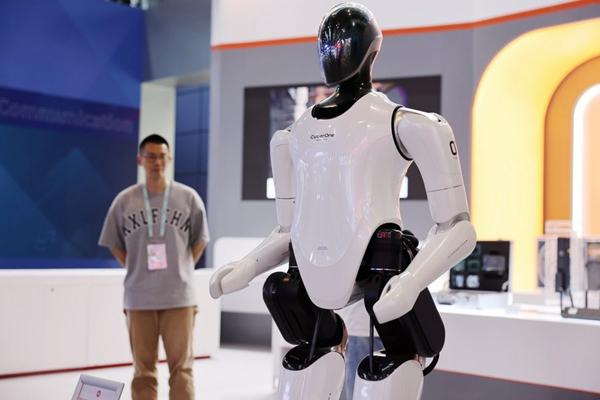
This photo taken on May 26, 2023 shows a full-size humanoid bionic robot displayed at the exhibition center of Zhongguancun National Independent Innovation Demonstration Zone in Beijing, capital
When walking into the ongoing 2023 Zhongguancun Forum exhibition, visitors would encounter various robots providing services such as delivery, reception, guidance, and information inquiry.
The rich application scenarios of artificial intelligence (AI) technology created by Chinese enterprises have come under the spotlight at the exhibition, mirroring the country's efforts in accelerating AI applications to power and upgrade the real economy.
At the booth of Changmugu, a Beijing medical enterprise focusing on orthopedic AI and surgical robot solutions, a surgical robotic arm attracted a continuous stream of visitors.
"Before surgery, doctors will achieve 3D images of bones through AI technology and calculate the most suitable surgical plan for patients through big data. The robotic arm will conduct the operation with the help of a surgical navigation system," Zhang Yiling, chairman of the company, introduced its orthopedic surgery diagnosis and treatment system.
The system can help reduce the difficulty, shorten the time, and improve the accuracy of operations, as well as reduce postoperative complications, said Zhang.
"With AI technology, the 3D printing model truly restores the structure of cerebral blood vessels, which is very useful in medical research and teaching," said Zhang Peng, the product manager of UnionStrong (Beijing) Technology Co., Ltd. "Our 3D printing model of intracranial vascular equipped with a surgical simulator helps doctors conduct preoperative exercises and postoperative simulations."
According to Zhang, the company's product line now covers the prevention, screening, diagnosis, treatment, and rehabilitation of cerebrovascular diseases. It has cooperated with many hospitals nationwide to optimize the application of AI products in clinical diagnosis and treatment.
"China has already entered the ranks of the world's leading medical AI research countries. Chinese companies and medical institutions are actively promoting more AI-enabled medical treatment methods and models," Zhang added.
The scenario innovations in the medical sector reflect China's efforts in promoting the deep integration of AI and the real economy.
In a move to accelerate the AI application and foster a new growth point of the national economy, in August 2022, China released a document pledging support to AI applications in 10 scenarios including farming, mining, autonomous driving, and medical services.
Thanks to these supportive policies, China has emerged as a pioneer in AI development in recent years. By 2022, China had secured the top position globally in terms of the number of patent applications filed for AI technologies, with the scale of the core AI industry surpassing 500 billion yuan (about 70.66 billion U.S. dollars), while more than 4,200 major enterprises operated, comprising approximately 16 percent of the global total.
Since 2020, China has entered a rapid development period for large AI models. Currently, the total number of published large AI models in China and the United States accounts for more than 80 percent of the global total, said Zhao Zhiyun, director of the Institute of Scientific and Technical Information of China.
"AI has become the focus of human innovation, and the era of AI with large models as the core has led technological innovation," said Robin Li, board chair and CEO of Baidu. "AI applications based on large models can serve transportation, energy, and other fields in the real economy."
"While we have brought a proliferation of large AI models, we should accelerate their application in different industries of the real economy," said Zhou Ming, former vice president of Microsoft Research Asia.
China's advantage in AI development lies in its rich application scenarios created during the intelligent upgrading of the real economy. Zhou added AI technology should combine with application scenarios to play its most optimal role.
Running from May 25 to 30, the 2023 Zhongguancun Forum has drawn top scientists, institutions, and well-known innovation and entrepreneurship entities globally to discuss international cooperation on sci-tech development and innovation.
As a sideline event, the exhibition has attracted the participation of about 650 enterprises and institutions worldwide to showcase their cutting-edge sci-tech advances and achievements in information technology, intelligent manufacturing, medicine and health, and the digital economy.




